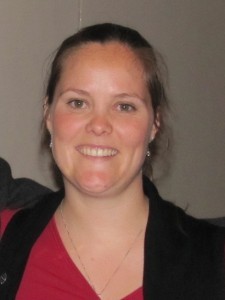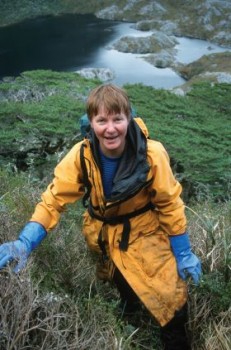Two seabird conservationists have recently received receive prestigious awards for work with albatrosses and other seabirds: Bronwyn Maree of South Africa has received the Future for Nature Award for 2014 and Barbara Wienecke from Australia has been awarded the Australian Antarctic Medal.
The Future for Nature Award 2014, an international, competitive award for young conservationists, has been won by South African Bronwyn Maree. Bronwyn leads BirdLife International’s Albatross Task Force (ATF) in South Africa, working through BirdLife South Africa. She is one of three winners chosen from 10 nominees out of 126 applications from 58 countries. The international award comes with a purse of €50 000 to be used for a project of her choice. Bronwyn was also a top ten finalist for the Future for Nature 2013 Award.
Bronwyn Maree joined the South African ATF team in 2008 as an instructor and was promoted to its leader in 2010. According to the Future for Nature Foundation “Since implementing ATF-recommended measures, seabird mortalities have decreased [in South African waters] by an amazing 75-95% (most notably albatross mortalities) in the foreign-flagged longline fishery and the domestic trawl fishery, saving thousands of endangered seabirds each year. Bronwyn has collected at-sea data on interactions of seabirds with fishing gear on 40 sea trips in five years on board commercial trawlers, conducted and overseen scientific experiments testing new technologies, and trained skippers, crew and even the fishing industry’s CEOs. Under Bronwyn’s leadership, new sources of mortality have been found and creative solutions have been devised, agreed to by government and industry, and implemented in legally binding permits.”
Read more on Bronwyn Maree’s work to help conserve albatrosses and petrels and her award here.

Bronwyn Maree
Barbara Wienecke was awarded the Australian Antarctic Medal in June last year (click here). “Barb” is a Senior Ecologist with the Australian Antarctic Division where she has worked for two decades and is best known for her research on penguins on the Antarctic Continent: “Dr Wienecke is highly regarded on the world stage and should be applauded for her long-term work with seabirds, particularly penguins, often at remote field locations in cramped and uncomfortable conditions and at the mercy of extreme weather conditions.”
However, she has also worked with albatrosses and petrels, both on land at sea, co-publishing on mitigating seabird bycatch on longliners (working closely with fellow Australian Antarctic Medal Awardee, Graham Robertson) and on field work conducted on Chilean islands (see below). Recently Barb has been supporting the Albatrosses and Petrel Agreement by contributing several illustrated texts to the ACAP Breeding Site Series.

Barb Wienecke on Isla Diego de Almagro, Chile in 2001
Selected References:
Hindell, M.A., Bost, C.A., Charrassin, J.B., Gales, N., Lea, M.A., Goldsworthy, S., Page, B., Robertson, G., Wienecke, W., O'Toole, M. & Guinet, C. 2011. Foraging habitats of top predators, and areas of ecological significance, on the Kerguelen Plateau. In: Duhamel, G. & Welsford, D. (Eds). The Kerguelen Plateau: Marine Ecosystem and Fisheries. Société d'Ichtyologie 2011: 203-215.
Johnson, J. 2013. Australian Antarctic Medal celebrates 25 years. Australian Antarctic Magazine 25: 24-25.
Lawton, K., Robertson, G., Valencia, J., Wienecke, B. & Kirkwood, R. 2003. The status of Black-browed Albatrosses Thalassarche melanophrys at Diego de Almagro Island, Chile. Ibis 145: 502-505.
Melvin, E.F., Sullivan, B., Robertson, G. & Wienecke, B. 2004. A review of the effectiveness of streamer lines as a seabird by-catch mitigation technique in longline fisheries and CCAMLR streamer line requirements. CCAMLR Science 11: 189-201.
Pyper, W. 2013. Penguin Barb. Australian Antarctic Magazine.
Robertson, G., McNeill, M., Smith, N., Wienecke, B., Candy, S & Olivier, F 2006. Fast sinking (integrated weight) longlines reduce mortality of white-chinned petrels (Procellaria aequinoctialis) and sooty shearwaters (Puffinus griseus) in demersal longline fisheries. Biological Conservation 132: 458-471.
Robertson, G., Moreno, C., Arata, J.A., Candy, S.G., Lawton, K., Valencia, J., Wienecke, B., Kirkwood, R., Taylor, P. & Suazo, C.G. 2014. Black-browed albatross numbers in Chile increase in response to reduced mortality in fisheries. Biological Conservation 169: 319-333.
Seco Pon, J.P., Wienecke, B. & Robertson, G. 2007. First record of Salvin's Albatross (Thalassarche salvini) on the Patagonian Shelf. Notornis 54: 49-51.
Sullivan, B.J., Kibel, P., Robertson, G., Kibel, B., Goren, M., Candy, S.G. & Wienecke, B. 2012. Safe Leads for safe heads: safer line weights for pelagic longline fisheries. Fisheries Research 134-136: 125-132.
Wienecke, B., Leaper, R., Hay, I. & van den Hoff, J. 2009. Retrofitting historical data in population studies: Southern Giant Petrels in the Australian Antarctic Territory. Endangered Species Research 8: 157-164.
John Cooper, ACAP Information Officer, 30 January 2013

 English
English  Français
Français  Español
Español